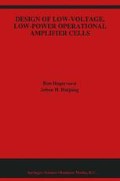Abstract
The main purpose of the input stage of an operational amplifier is to amplify differential signals and to reject common-mode input voltages. An important specification of an input stage is the common-mode input range. If the common-mode voltage is kept within this range, the input stage will properly respond to small differential signals. Hence, an application has to be designed such that the common-mode input voltage stays within the common-mode input range. Other important specifications of the input stage are the input referred noise, offset and the common-mode rejection ratio.
Access this chapter
Tax calculation will be finalised at checkout
Purchases are for personal use only
Preview
Unable to display preview. Download preview PDF.
References
P.R. Gray and R.G. Meyer, “Analyses and Design of Analog Integrated Circuits”, Wiley, New York, USA, 1984.
P.E. Allen, D.R. Holberg, “CMOS Analog Circuit Design”, Holt, Rinehart and Winston, Inc., Fort Worth, USA, 1987.
J.H. Huijsing, “Integrated Circuits for Accurate Linear Analogue Electrical Signal Processing”, Ph.D. dissertation, Delft University of Technology, Delft, The Netherlands, 1981.
M.J.M Pelgrom, A.C.J. Duinmaijer, A.P.G. Welbers, “Matching Properties of MOS Transistors”, IEEE J. Solid-State Circuits, vol. SC-23, Oct. 1989, pp. 1433–1439.
K.R. Lakshmikumar, R.A. Hadaway, M.A. Copeland, “Characterization and Modeling of Mismatch in MOS Transistors for Precision Analog Design”, IEEE J. Solid-State Circuits, vol. SC-21, no. 6, December 1986, pp. 1057–1066.
Y. Chang, W. Sansen, “Low-Noise Wide Band Operational Amplifiers in Bipolar and CMOS Technologies”, Kluwer Academic Publishers, Boston, USA, 1991.
J.H. Huijsing and D. Linebarger, “Low-Voltage Operational Amplifier with Rail-to-Rail Input and Output Ranges”, IEEE J. Solid-State Circuits, vol. SC-20, Dec. 1985, pp. 1144–1150.
M.D. Pardoen and M.G. Degrauwe, “A Rail-to-Rail Input/Output CMOS Power Amplifier”, IEEE J. Solid-State Circuits, SC-25, Dec. 1990, pp. 501–504.
R. Hogervorst, R.J. Wiegerink, P. AL, de Jong, J. Fonderie, R.F. Wassenaar, J.H. Huijsing, “CMOS Low-Voltage Operational Amplifiers with Constant-gm Rail-to-Rail Input Stage”, Analog Integrated Signal Processing, vol. 5, 1994, pp. 135–146.
R. Hogervorst, J.P. Tero, R.G.H. Eschauzier, J.H. Huijsing, “A Compact 3-V CMOS Rail-to-Rail Input/Output Operational Amplifier for VLSI Cell Libraries”, IEEE Journal of Solid-State Circuits, SC-29, Dec. 1994, pp. 1505–1512.
R.F. Wassenaar, J.H. Huijsing, R.J. Wiegerink, R. Hogervorst and J.P. Tero, “Differential amplifier having rail-to-rail input capability and square root current control”, US patent, patent no. 5,371,474, December 6, 1994.
J.H. Huijsing, R. Hogervorst, “Rail-to-Rail Input Stages with Constant gm and Constant Common-Mode Output Currents”, US patent application, Appl. no. 08/625,458, filed March 29, 1996.
J.H. Huijsing, R. Hogervorst, J.R Tero, “Compact CMOS Constant-gm Rail-to-Rail Input Stages by Regulating the Sum of the Gate-Source Voltages Constant”, US patent application, Appl. no. 08/ 523, 831, filed September 6, 1995.
R. Hogervorst, J.R Tero, J.H. Huijsing, “Compact CMOS constant-gm rail-to-rail input stage with gm control by an electronic zener diode”, Proceedings ESSCIRC 1995, Lille, France, 19–21 September 1995, pp. 78–81.
R. Hogervorst, J.H. Huijsing, J.R Tero, “Rail-to-rail input stages with gm control by multiple input stages”, US patent application, Appl. no. 08/430,517, filed April 27, 1995.
R. Hogervorst, S.M. Safai, J.R Tero, J.H. Huijsing, “A Programmable 3-V CMOS Rail-to-Rail Opamp with Gain-Boosting for Driving Heavy Resistive Loads”, Proceedings IEEE International Symposium on Circuits and Systems, Seattle, USA, April 30-May 3 1995, pp. 1544–1547.
Author information
Authors and Affiliations
Rights and permissions
Copyright information
© 1996 Springer Science+Business Media Dordrecht
About this chapter
Cite this chapter
Hogervorst, R., Huijsing, J.H. (1996). Input Stages. In: Design of Low-Voltage, Low-Power Operational Amplifier Cells. The Springer International Series in Engineering and Computer Science, vol 374. Springer, Boston, MA. https://doi.org/10.1007/978-1-4757-2489-9_3
Download citation
DOI: https://doi.org/10.1007/978-1-4757-2489-9_3
Publisher Name: Springer, Boston, MA
Print ISBN: 978-1-4419-5165-6
Online ISBN: 978-1-4757-2489-9
eBook Packages: Springer Book Archive

